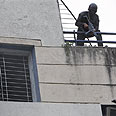
Terror in Mumbai
צילום: AP
Room for concern
Despite progress achieved in Israel’s’ anti-terror preparations, some vulnerabilities still exist
Part 2
Is the State of Israel prepared for coping with a series of simultaneous terror attacks, or will it face complete paralysis, helplessness, and chaos – as we saw in India in recent days? Do we have contingency plans for such scenarios? Are rescue forces prepared to face them?
None of these questions has an unequivocal answer, as Israel never held drills simulating mass terror attacks at various sites of the scope described here. However, every year authorities hold drill simulating 3-4 incidents taking place simultaneously, while using less dramatic scenarios.
This year, for example, the “White Autumn” drill simulated terror attacks carried out by a suicide bomber coupled with a drive-by shooting in Eilat, at the Ashdod Port, and in central Tel Aviv. Similar drills are held at least twice a year, including some undertaken without advance notice.
The drills’ results show that the defense establishment is able to contain the incidents within a reasonable timeframe – two to three hours – without paralyzing life across the country or in a given city for more than a few hours. Still, many vulnerabilities were identified pertaining to coordination between the forces, collapsing phone systems, etc. There are also vulnerabilities pertaining to non-conventional warfare.
However, great progress has been made in respect to identifying hijacked airplanes approaching Israel. Improvements have also been achieved in the security screening of shipping containers, and that’s significant.
Yet can the Israel Police cope with six or seven large-scale incidents taking place simultaneously and requiring a takeover of hostile elements, hostage rescue, mobilization of forces, sealing off various sites, and taking care of non-conventional substances and thousands of casualties?
This question can only be answered via drills simulating extreme scenarios; however, these scenarios have not been simulated here. Still, quite a few lessons have been drawn from the scenarios that were simulated. Officials decided, for example, that the city of Eilat must operate autonomously in terms of rescue services and intervention forces. For that reason, an anti-terror force comprising reservist soldiers is stationed in Eilat regularly.
The difference between us and the Indians is first and foremost a matter of awareness. A state like Israel, which copes with terrorism on a regular basis, is prepared for the possibility of a mass attack at various sites – we are ready for it both in terms of awareness and organizational preparation. The forces are there. Most of the required equipment is available. The coordination between the forces is a matter of additional exercises. In theory, we are approaching a state where our readiness level is “ok.”
However, in reality, when we see central Israel paralyzed because a sign on a Tel Aviv bridge was damaged, there is room for concern.










